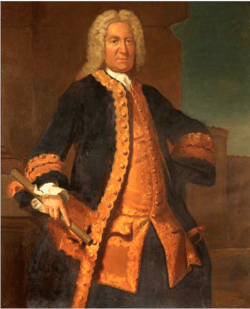Battle of Winnepang facts for kids
Quick facts for kids Battle of Winnepang |
|||||||
|---|---|---|---|---|---|---|---|
| Part of Dummer's War | |||||||
 Richard Philipps, Governor of Nova Scotia and Commander of the 40th Regiment of Foot |
|||||||
|
|||||||
| Belligerents | |||||||
| New England colonists | Mi'kmaq | ||||||
| Commanders and leaders | |||||||
|
Unknown | ||||||
| Strength | |||||||
| ~30 militia | 39 warriors | ||||||
| Casualties and losses | |||||||
| 5 killed | 35 killed | ||||||
The Battle of Winnepang was a naval fight during Dummer's War. It happened in July 1722 at a place called Winnepang, which is now Jeddore Harbour in Nova Scotia. In this battle, forces from New England attacked Mi'kmaq warriors.
The main goal of the New England forces was to get back over 82 prisoners. These prisoners were New Englanders who had been captured by the Mi'kmaq from fishing boats off the coast of Nova Scotia. Ensign John Bradstreet and fishing Captain John Elliot led the New England group.
Contents
Why the Battle Happened
Rising Tensions in Nova Scotia
Dummer's War started because British settlements were growing. They were expanding along the Kennebec River in what is now Maine. Also, more New England fishermen were moving into the waters around Nova Scotia.
The Treaty of Utrecht in 1713 had ended a previous war, Queen Anne's War. This treaty helped the British expand. However, the Native tribes of the Wabanaki Confederacy were not part of this treaty. They were not asked for their opinion. Because of this, they protested by raiding British fishermen and settlements.
Forts and Conflicts
To respond to these raids, the Governor of Nova Scotia, Richard Philipps, built a fort. This fort was built in 1720 at Canso, which was traditional Mi'kmaq land. At the same time, Massachusetts Governor Shute built forts on traditional Abenaki land. These forts were at the mouth of the Kennebec River.
Building these forts made things very tense. By 1722, these tensions led to open fighting, starting Dummer's War.
Blockade and Hostages
In July 1722, the Abenaki and Mi'kmaq tried to cut off supplies to Annapolis Royal. This was the capital of Nova Scotia. They captured 18 fishing boats and many prisoners. These captures happened between Cape Sable and Canso. They also took boats and prisoners in the Bay of Fundy.
One of the captured boats was carrying a year's worth of food for Annapolis Royal. The Maliseet, another Native group, took a boat. They used it to carry 45 warriors to join 120 Mi'kmaq warriors. These warriors planned to march against Annapolis Royal.
To protect the capital and free the prisoners, Lieutenant Governor John Doucett took 22 Mi'kmaq as hostages. Soon after the blockade began, Massachusetts Governor Shute declared war on the Wabanaki Confederacy. The war is named after Lieutenant Governor William Dummer. He became the acting Governor in 1723.
The Battle of Winnepang
New England Forces Attack
Right after war was declared, Governor Philipps sent out two ships on July 22. Captain John Elliot and Captain John Robinson led these ships. Their mission was to protect the fishing areas near Canso. They also needed to get back the New England prisoners.
There was a Mi'kmaq camping spot near Canso, at what is now West Jeddore. At Winnepang (Jeddore Harbour), there were 39 Mi'kmaq warriors. They were holding prisoners in seven captured vessels.
The Fight at Sea
Captains Elliot and Bradstreet arrived in the harbour. They attacked the Mi'kmaq in a two-hour naval battle. Bradstreet led a group that boarded the Mi'kmaq vessels. They used hand grenades and well-aimed gunfire to defeat the Mi'kmaq.
The New Englanders had five men killed and several injured. Captain Elliot was badly wounded. As the Mi'kmaq tried to swim away to shore, the New Englanders fired at them. Thirty-five Mi'kmaq warriors were killed. The New Englanders managed to rescue fifteen prisoners from the vessels. They also found that nine prisoners had been killed.
What Happened Next
Prisoner Exchanges and Captures
After the battle, efforts continued to free the New England prisoners. James Blinn helped arrange a prisoner exchange at Canso. He successfully got 24 fishermen released. Later, Blinn captured three or four more Native people at Cape Sable Island.
In another mission, Captain Robinson captured ten vessels. He also killed three Abenaki warriors. Robinson warned the Mi'kmaq not to hurt the New England prisoners. He reminded them that the New Englanders still held Mi'kmaq hostages at Annapolis Royal.
Robinson then went to Malagash harbour. There, Native people held five fishing vessels and twenty prisoners. Robinson paid a ransom, and these prisoners were released. Captain Cyprian Southack also killed one Mi'kmaq and captured five more near the Gut of Canso.
Some of the Native people had sent sixteen prisoners to what is now Richibucto, New Brunswick.

